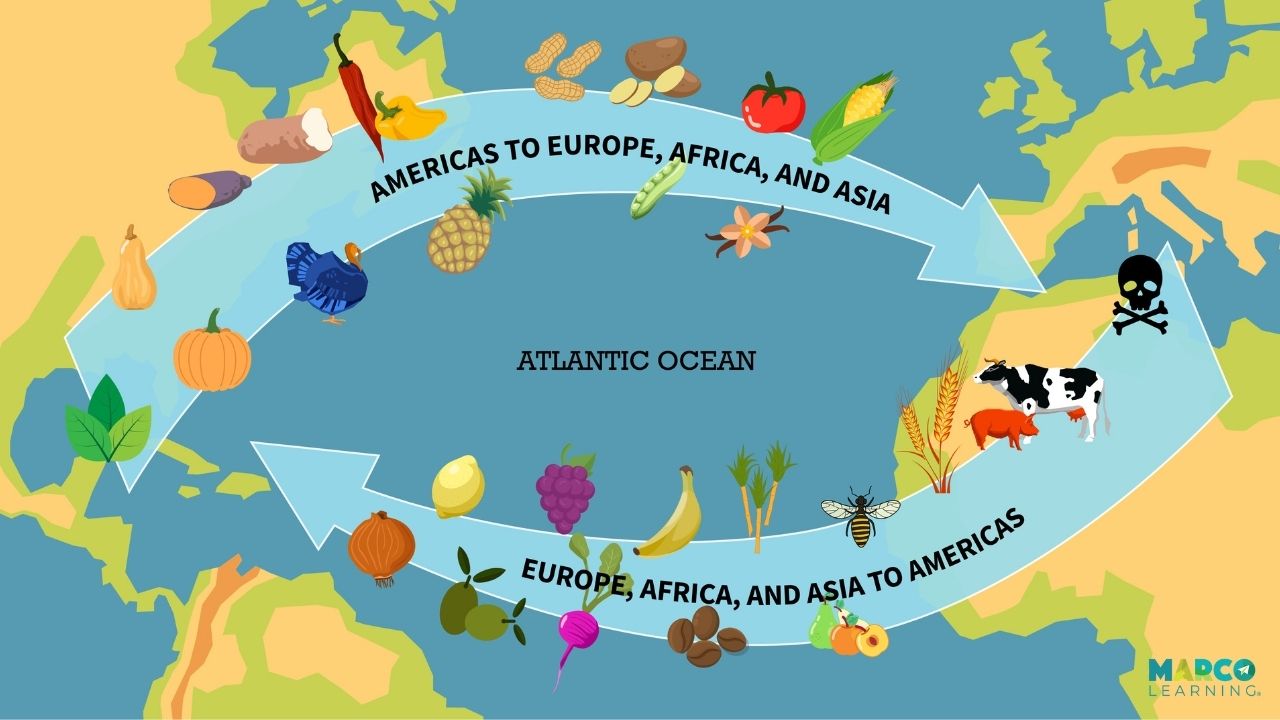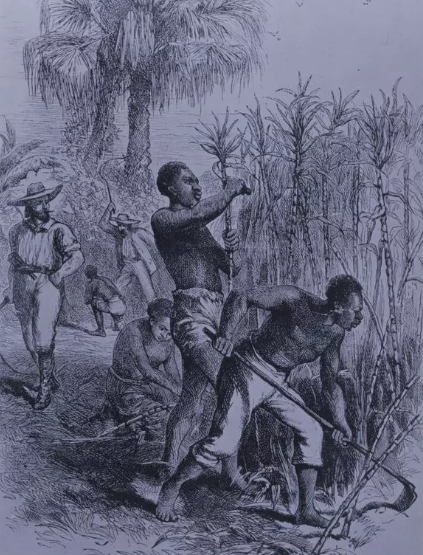1.4 Columbian Exchange, Spanish Exploration, and Conquest
5 min read•june 18, 2024
Dalia Savy
Will Pulgarin
AP US History 🇺🇸
454 resourcesSee Units
A big key focus of this key topic is on geography and the environment, as the age of exploration impacted natural ecosystems as well. Before 1492, when Columbus "discovered" the Americas, the Americas were isolated from Africa, Europe, and Asia. The plants, animals, people, and diseases of the Americas were all contained in the Western Hemisphere. You can imagine how much this changed once the two hemispheres started interacting and its effect on the environment and people.
Columbian Exchange
The Columbian Exchange was a period of rapid exchange of plants, animals, ideas, technology, and diseases between the Eastern and Western Hemispheres. Some of the notable exchanges that took place during the Columbian Exchange include:
- Introduction of new crops: The Columbian Exchange introduced new crops to both the Old World and the New World, such as potatoes, maize, and tomatoes. These crops had a major impact on agriculture and the food systems of both regions.
- Introduction of new animals: The Columbian Exchange also introduced new animals to both regions, including horses, cattle, and pigs. These animals had a major impact on transportation, agriculture, and the environment.
- Spread of diseases: The Columbian Exchange also led to the spread of diseases between the Old World and the New World. Many diseases, such as smallpox and influenza, had a devastating impact on the indigenous populations of the Americas.
- Cultural exchange: The Columbian Exchange also facilitated the exchange of ideas, religions, and cultures between the Old World and the New World. This had a major impact on the social and cultural development of both regions.
Flow of Trade
Let's first tackle the introduction of new crops and animals! Note that the "Old World" refers to Africa, Asia, and Europe, while the "New World" refers to the Americas.
- Old World to New World: horses 🐎, pigs 🐖, rice 🍚, wheat 🌾, grapes 🍇
- New World to Old World: corn 🌽, potatoes 🥔, chocolate 🍫, tomatoes 🍅, avocado 🥑, sweet potatoes 🍠
The introduction of new crops to Europe helped to increase food production and stimulate population growth. These crops, which were well-suited to the European climate and soil, became important staples in the European diet and helped to improve the lives of many people.
In addition to new crops, the Columbian Exchange also brought new sources of mineral wealth to Europe from the Americas, including gold, silver, and other precious metals. The discovery of these resources helped to stimulate trade and commerce in Europe, and the wealth generated by this trade contributed to the development of a more capitalist economy in Europe. The shift from feudalism to capitalism, which was already underway in Europe, was facilitated by the influx of wealth and resources from the Americas.

Okay, so what about diseases? Prior to the exchange, the two regions had developed relatively isolated ecosystems, and many of the diseases that were present in one region were not found in the other. This allowed the Native populations to develop immunity to the diseases in their respective regions.
With the exchange, the interaction between people, plants, and animals also led to the spread of diseases to which people were never exposed. Diseases such as mumps, measles, typhus, and smallpox ended up ravaging the Native American populations because they had no immunity to European diseases.
Yes, there was also a spread of diseases from the Americas to Europe, such as syphilis, which impacted European well-being, but the effects were not as detrimental. To put it in perspective, the Taino people, who greeted Columbus in San Salvador, numbered approximately 300,000 in 1492. By 1508, fewer than 100,000 survivors lived on the island.
Colonization
Native Americans did not submit easily to colonization by European powers, and many indigenous societies put up fierce resistance to the colonizers' attempts to take over their lands and resources. In some cases, native peoples were able to successfully defend their territories and maintain their independence, while in others they were able to negotiate favorable terms with the colonizers.
However, in many cases, native peoples were not able to successfully resist colonization, and they were subjected to violence, exploitation, and displacement by the colonizers. One factor that contributed to the ability of the European powers, particularly Spain, to take over much of the Americas was the devastating impact of European diseases on the indigenous populations.
The high mortality rates caused by these diseases, combined with the violence and exploitation of the colonizers, contributed to the weakening of native societies and made it easier for the Europeans to take control.
🎥Watch AP US History teacher Will Pulgarin discuss the early interactions between European explorers and Native Americans.
Native vs. European Views
| Native Americans | Society | Europeans |
| Regarded the land as the source of life, not as a commodity to be sold. | View of Land | Believed that the land should be tamed and in private ownership of land. |
| Thought of the natural world as filled with spirits. Some believed in one supreme being. | Religious Beliefs | The Roman Catholic Church was the dominant religious institution in western Europe. The pope had great political and spiritual authority. |
| Bonds of kinships ensured the continuation of tribal customs. The basic unit of organization among all Native American groups was the family, which included aunts, uncles, cousins, and other relatives. | Social Organization | Europeans respected kinship, but the extended family was not as important to them. Life centered around the nuclear family (father and mother and their children). |
| Assignments were based on gender, age, and status. Depending on the region, some women could participate in the decision-making process. | Division of Labor | Men generally did most of the field labor and herded livestock. Women did help in the fields, but they were mostly in charge of child care and household labor. |
Practice Short Essay Set (SEQ)
On the AP US History examination in May, you will be given three short answer questions, where you will be asked to analyze historians' interpretations, historical sources, and propositions about history. Take a shot at the following unit one question once you review the next study guide about the Atlantic slave trade:

Schomburg Center for Research in Black Culture, Photographs and Prints Division, The New York Public Library
- Briefly explain one event that gave rise to the labor system portrayed in the picture.
- Briefly explain another event that gave rise to the labor system portrayed in the picture.
- Briefly explain how the scene impacted the Atlantic World.
Try not to look below until you write answers to the above questions! The following are possible answers to elaborate upon for numbers one and two:
- Failure of the encomienda system
- diseases killed off Native American labor force
- Columbian Exchange increased the need for the exchange of goods and therefore increased the demand for labor in the New World
- Slave trade becoming profitable as demand grew.
The following are possible key ideas that you could discuss for number three:
- Brought Europeans, Native Americans, and Africans into one society.
- Increased the demand for slaves in the colonies and gave rise to the triangular trade.
- The slave trade devastated African societies, which lost 1/5th of their fittest members. It drained Africa of at least 12 million people.
Browse Study Guides By Unit
🌽Unit 1 – Interactions North America, 1491-1607
🦃Unit 2 – Colonial Society, 1607-1754
🔫Unit 3 – Conflict & American Independence, 1754-1800
🐎Unit 4 – American Expansion, 1800-1848
💣Unit 5 – Civil War & Reconstruction, 1848-1877
🚂Unit 6 – Industrialization & the Gilded Age, 1865-1898
🌎Unit 7 – Conflict in the Early 20th Century, 1890-1945
🥶Unit 8 – The Postwar Period & Cold War, 1945-1980
📲Unit 9 – Entering Into the 21st Century, 1980-Present
📚Study Tools
🤔Exam Skills
👉🏼Subject Guides
📚AMSCO Notes

Fiveable
Resources
© 2025 Fiveable Inc. All rights reserved.